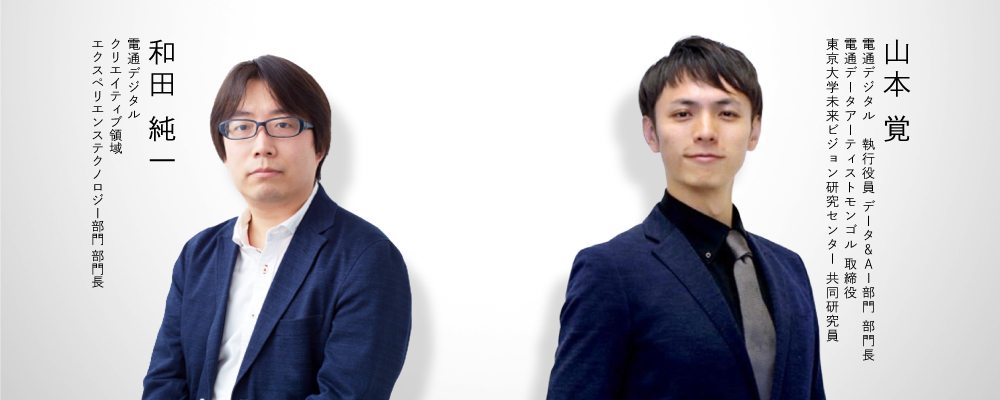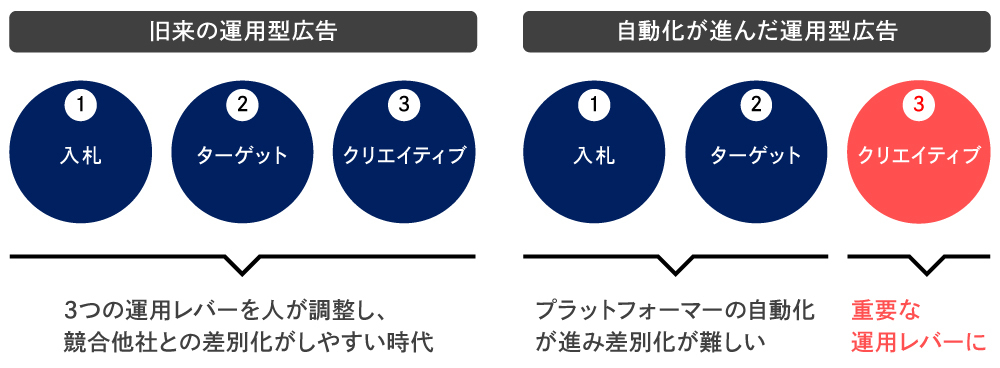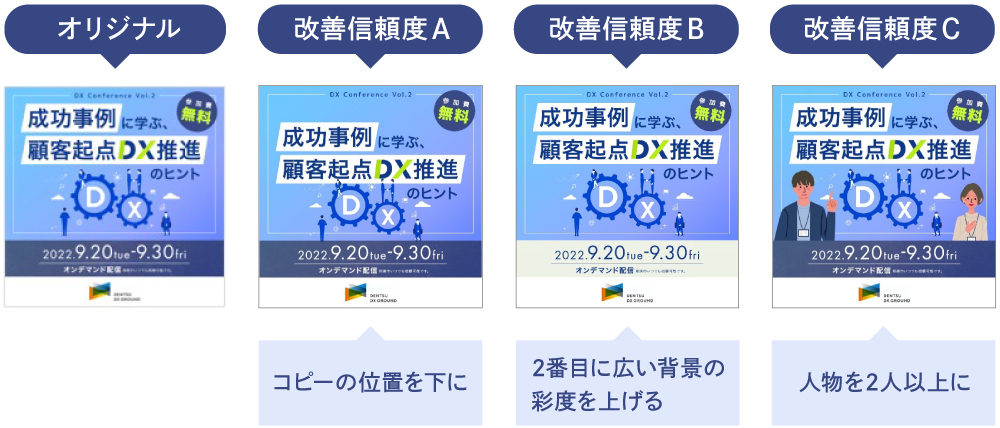Dentsu Inc.'s "Business Growth Practice Webinar" series shares the latest insights on the ever-evolving business landscape. This series highlights key sessions from the Business Growth Practice Webinar 2022 by Dentsu Inc. People Driven Marketing, featuring interviews with the presenters.
This time, the theme is AI utilization in digital advertising. While traditional AI applications focused heavily on predicting ad effectiveness, the future will see
① Identifying appeal axes
② "Creative (CR) Generation"
③ "Effect Prediction"
④ "Improvement Suggestions"
— essentially, the entire production process.

"∞AI (Mugen AI)" optimizes every step of digital ad production with AI.
This time, we spoke with two experts: Junichi Wada of Dentsu Digital Inc., who has long been involved in the creative field of digital advertising, and Satoru Yamamoto, who has developed numerous AI-powered marketing solutions. We discussed the current state of Creative × AI and Dentsu Digital Inc.'s solution, "∞AI (Mugen AI)".
Quality, quantity, speed. AI utilization in digital creative is now indispensable!
──What exactly is Dentsu Group's "∞AI"?
Yamamoto: "∞AI" is a solution that utilizes four AI systems corresponding to four processes in digital ad operations. It identifies the core appeal of ads, automatically generates creative assets, and further supports effect prediction and improvement.
Wada: In digital advertising, it's essential to discover the right appeal axis, prepare creative tailored to each platform's characteristics, and then improve based on delivery results. Doing all this solely with human effort has its limits.
We named it "∞AI" because we want to leverage AI to enable "infinite" growth for companies' digital marketing. While the Dentsu Group has developed various AI solutions before, this solution brings together the full force of our capabilities.
──Thank you. We'll discuss the four AI systems in detail later, but first, could you tell us about the current use of AI in digital advertising?
Wada: Currently, the most mainstream form of advertising spending is "programmatic advertising." To secure a single impression on platforms like search engines or social media, you must win the auction. In this context, three operational levers were crucial: "bidding," "targeting," and "creative," all adjusted based on user response.
However, as platforms increasingly automate (AI-enable) bidding and targeting, making differentiation from competitors harder, the importance of the "creative" lever has grown significantly.
──What are the key elements for improving the effectiveness of creatives in performance advertising?
Wada: It involves running the PDCA cycle while monitoring user responses. In this process, "quality," "quantity," and "speed" are crucial. Let's examine each:
① Quality of Creative... Discovering the Right Appeal
In earlier programmatic advertising, "ad groups" classifying targets were segmented quite finely. However, with the advancement of platform AI today, the approach is to broadly capture targets by their needs and maximize the platform's optimization capabilities. To achieve this, developing the right "appeal axis" that resonates with the target's needs is crucial.
② Quantity of creatives... Prepare creatives for each media and target
Next is the "quantity" of creatives. Platforms for digital advertising—social media, search engines, e-commerce malls—continue to proliferate, requiring creatives tailored to each medium's characteristics. Furthermore, creatives must also be differentiated based on the aforementioned appeal axes. Producing creatives for every possible combination of medium × appeal axis results in a substantial volume.
③ Speed of Creative Development... Implementing PDCA cycles for immediate improvements based on data
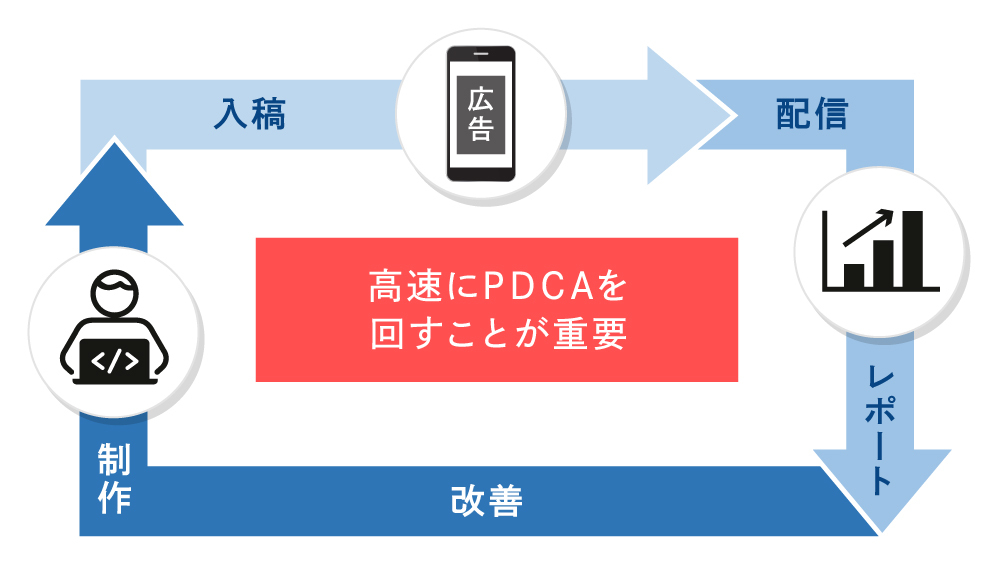
Finally, the "speed" of creative delivery. For performance-based advertising where metrics are available in real time, the speed of making immediate improvements based on those metrics is crucial. The faster you can accelerate the cycle of production, submission, delivery reporting, and improvement, the more effectively your advertising performance will be optimized.
There are limits to how much one creator or one operator can continuously improve effectiveness, which is where AI comes into play.
──How is AI being utilized to improve effectiveness?
Wada: In the advertising world until now, AI utilization has mostly focused on "performance prediction." The defining feature of this "∞AI" is its focus on the entire creative production process. From discovering appeal axes, to generating creatives, to providing specific suggestions on where to focus improvements—it can handle all of this consistently within a single solution.
Yamamoto: For the development of "∞AI," AI specialists from Dentsu Digital Inc., who won gold medals at global AI competitions, served as supervisors. The Dentsu Group is also conducting joint research with the University of Tokyo AI Center (Center for Advanced Intelligence Project), developing it with an extremely powerful team.

Deeply understand your target audience. "Appeal Axis Discovery AI" and "Creative Generation AI"
──∞AI consists of four distinct AI components. Could you explain what each one does?
Yamamoto: I'll introduce them as the developer. First, the "Appeal Axis Discovery AI" and "Creative Generation AI".
① "Appeal Axis Discovery AI"……Automatically detects "expression angles" for each appeal axis
With ∞AI, simply input the product name or URL for which you want to generate creative. The AI automatically collects and organizes the information needed for ad creation from diverse data sources like "market data," "competitor data," and "company data."
Then, based on appeal axes like "function," "price," or "lifestyle," keywords that serve as "expressive angles" to resonate with users are automatically mapped. Furthermore, by training the AI with keywords you like, it progressively reflects the creator's insights, allowing the system itself to evolve.
──Specifically, how does the AI "discover" these appeal axes?
Yamamoto: The mechanism involves the AI automatically extracting keywords from various texts and assigning them to "appeal axes." Let's take a hypothetical diet service called "DD Diet" as an example. First, we prepare text like this:
"DD Diet offers customized plans tailored to each customer under the guidance of medical specialists. Payment plans are available, and right now we're running a first-time free campaign, so feel free to reach out."
The AI extracts appeal keywords from this text—such as "guidance from medical specialists," "customized plans," "installment payments," and "first session free"—and automatically assigns them to "appeal axes."
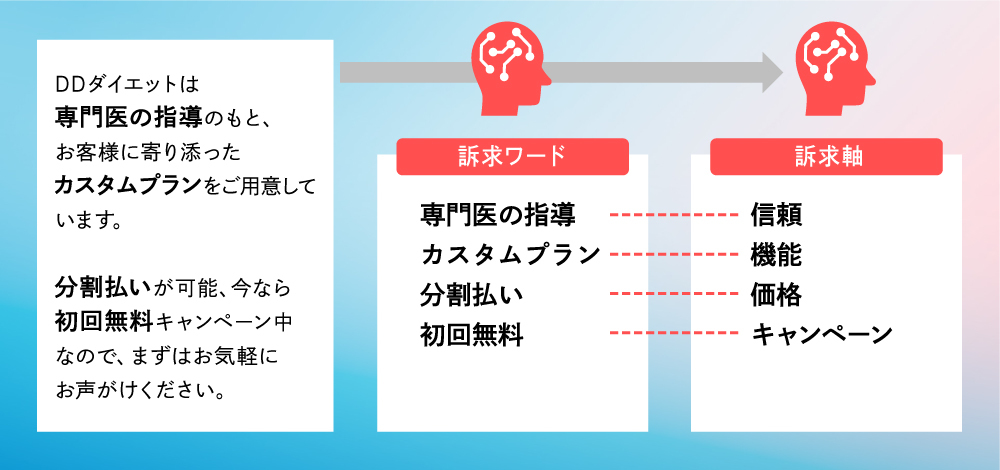
For example, "under the guidance of a specialist" is assigned to the "Trust" appeal axis. "Installment payments" is assigned to the "Price" appeal axis. Both keyword extraction and assignment achieve accuracy rates exceeding 90%.
② "Creative Generation AI"……Automatic Generation of Tagline Proposals
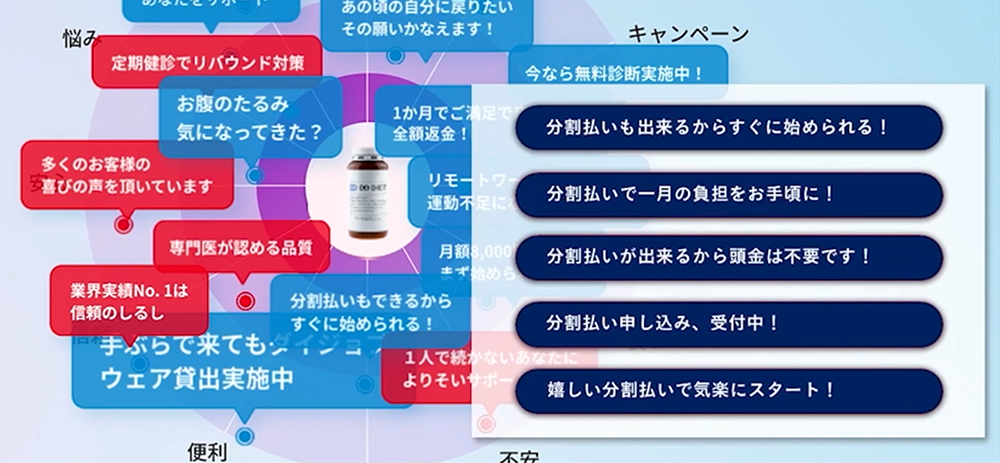
Instantly generates catchphrases based on appeal words automatically extracted by the "Appeal Axis Discovery AI." It can mass-produce not just one pattern, but multiple variations instantly.
──The second AI is the "Creative Generation AI," right?
Yamamoto: Based on appeal keywords like "installment payments" extracted by the "Appeal Axis Discovery AI," it automatically generates catchphrases when you input additional information like industry type as sub-details.
Using natural language processing, it automatically generates highly polished copy incorporating the product name and appeal keywords. The instructions given to the AI behind the scenes are similar to the following:
[Instruction]
Write a catchphrase for the "DD Card" product targeting people thinking "I suddenly need money."
【AI-generated copy】
"Need cash fast? DD Card. We deliver cash in as little as 1 hour."
*"DD Card" is a fictional card.
Here, since the target was "users thinking they need money urgently," the appeal keyword "as fast as 1 hour" was used. However, for copy targeting users thinking about medical expenses or travel costs, for example, different appropriate appeal keywords would be chosen.
──How much can humans influence the direction of the generated copy?
Yamamoto: You can provide instructions on the "writing style," such as "make it more formal" or "make it more casual." We've also included a "correctness check" function that verifies information against the original database.
──Regarding natural language processing, OpenAI's "ChatGPT" and similar technologies have generated significant buzz.
Yamamoto: When "∞AI" was first released, it used OpenAI's GPT-3 language model. We are now trialing the latest GPT-4, achieving further improvements in accuracy and flexibility.
Until recently, creating an AI for generating ad copy required training on 200,000 data points. Today's AI can grasp the "knack" even from smaller training datasets. Since GPT-3, training on just hundreds of copies is sufficient to acquire practical creative know-how. And "∞AI" has been trained on the Dentsu Group's years of refined expertise.
Automatically detects areas for improvement and outputs suggestions! "Effect Prediction AI" and "Improvement Suggestion AI"
──Next, let's discuss the "Effect Prediction AI" and "Improvement Suggestion AI." In digital advertising, measurable ad effectiveness is crucial, right?
Yamamoto: This is an area where AI has always excelled. Effect Prediction AI continuously learns from daily ad placement data across various platforms. Based on historical data, it can determine things like, "Banners with these creative elements tend to yield positive effects on these KPIs."
③ "Effect Prediction AI"……Predicts the advertising effectiveness of creatives
The Effect Prediction AI first breaks down the banner into numerous "creative elements." For example: Does the banner include a logo? Does it feature a product image? Is there a button directing users to the landing page (LP)? What is the content of the catchphrase? If people appear, their gender, age group, and number also become "elements." Furthermore, the AI automatically breaks down and extracts the overall color scheme and layout of the banner. Based on this analysis, it predicts the ad's effectiveness.
Operationally, it outputs predictions like "the probability that Creative A outperforms Creative B." Regarding the accuracy of these predictions, when comparing the actual win rates of past ads with the AI's predicted results, the correlation coefficient was 0.9 or higher, indicating a very strong proportional relationship.
──That's what we call a "winning pattern" in digital advertising. Traditionally, effectiveness was measured through methods like A/B testing.
Yamamoto: And creatives need to be optimized for each platform. The AI also learns this point, based on past ad data, determining things like "For this platform, this banner performs better." Furthermore, it doesn't just judge winning or losing patterns; it also learns specific KPIs, such as "This gets impressions easily but clicks are hard to come by."
──Finally, please tell us about the "Improvement Suggestion AI."
Yamamoto: This works in complete synergy with the "Effect Prediction AI." Once the "Effect Prediction AI" identifies underperforming creatives, ad groups, or campaigns, the "Improvement Suggestion AI" provides concrete improvement proposals.
④ "Improvement Suggestion AI" ... Extracts creatives needing improvement and provides specific suggestions
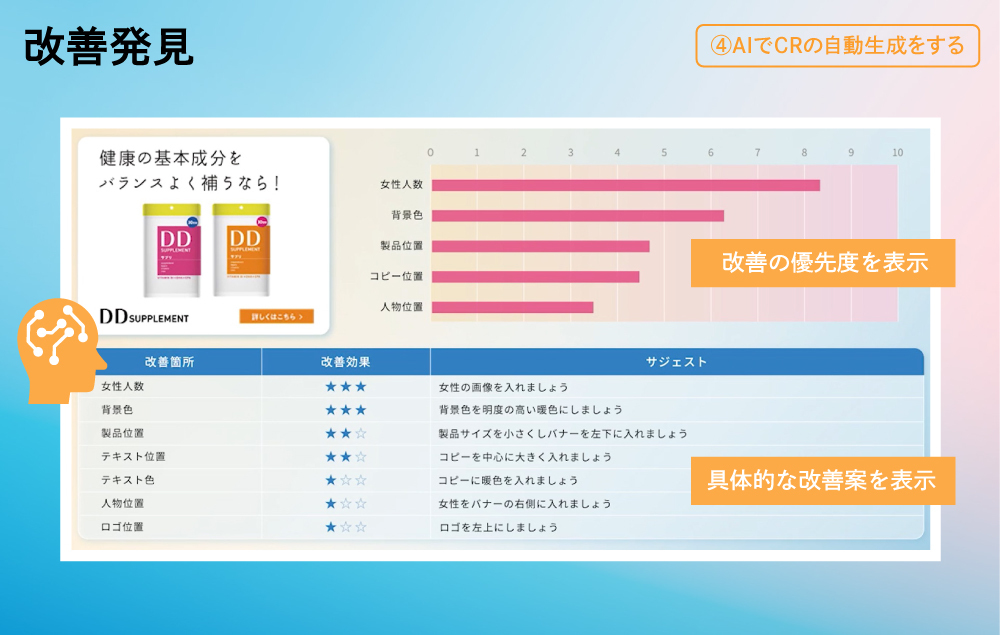

The AI automatically extracts campaigns, ad groups, and creatives needing improvement. It provides specific improvement suggestions tailored to the platform and KPIs.
It breaks down the creative elements generated by the "Creative Generation AI," picking out those with "the greatest potential for improvement and the highest priority for enhancement." It then displays highly effective, specific improvement suggestions. For example, it might propose, "Change the background color to a warmer, higher-brightness hue."
After implementing the suggested improvements, the "Effect Prediction AI" compares the improved creative with the original to calculate the predicted reliability of the improvement effect.
──So, these two AI tools enable us to extract "creatives needing improvement," suggest "key improvement points," and predict "post-improvement effectiveness."
Wada: In September 2022, Dentsu Digital Inc. was running banners to attract webinar attendees. We actually used ∞AI to implement improvements.
In order of priority:
- "Move copy position down" (Improvement Confidence A)
- "Increase saturation of the second-largest background area" (Improvement Confidence B)
- "Include two or more people" (Improvement Confidence C)
Following these AI suggestions, we created the creatives as instructed and distributed them alongside the original banner. The improvement with Confidence Level A clearly outperformed the original banner.
The relationship between generative AI and advertising creative is just beginning!
──Generative AI is evolving remarkably. Could you share your outlook for the future, including the use of GPT-4 mentioned earlier?
Yamamoto: When we released "∞AI" in 2022, we used the GPT-3 algorithm for natural language processing in "extracting appeal points" and "generating copy."
While the term "GPT" is highly associated with OpenAI's ChatGPT and Microsoft Bing featuring similar AI, it refers to a generative, pre-trained, general-purpose language processing AI technology. OpenAI released the new version, GPT-4, in March 2023, and we are also trialing its implementation in ∞AI.
Currently, only the text recognition and generation API(※1) for GPT-4 is publicly available. However, it is anticipated that image, video, and audio recognition and generation capabilities will be added in the future. Integrating these APIs into "∞AI" is expected to improve banner effectiveness prediction accuracy and enable features like automated banner generation using image generation.
※1=API (Application Programming Interface)
A mechanism enabling a program to connect with external applications. Currently, external companies and organizations are developing services utilizing GPT-4 through APIs released by OpenAI.
──Dentsu Group has been developing numerous AI solutions at a relatively early stage. Where do you see your competitive advantage?
Wada: As a communications company, the Dentsu Group has researched creativity for many years. By highly integrating this creative expertise with the latest technologies, including AI, we can provide solutions unique to the Dentsu Group.
Dentsu Digital Inc. includes employees who have won gold medals in international AI competitions, and we are constantly keeping pace with the latest technology, such as through joint research with the University of Tokyo AI Center.
──Finally, could you share your thoughts on the relationship between AI and creativity?
Yamamoto: At Data Artist (merged with Dentsu Digital Inc. in 2023), the company I founded, our corporate philosophy was "Systematize logic and focus on inspiration." AI excels at generalizing and mass-producing various things, but that's not the end goal.
By continuously "generalizing" the domains AI can handle, humans can focus their time on what only humans can do. We can pursue the sharpened, moment-by-moment "inspiration" that lies above what AI has "generalized." I hope we can continue building this world where humans and AI coexist.
Wada: What is creativity in the AI era? This is a question we ponder daily at the Dentsu Group. ∞AI's tagline is "Unlimited ideas and creativity for everyone." While "effectiveness" and "results" are crucial, the essence of creativity lies in connecting people and moving human emotions. We want to leverage AI's power to further expand human potential.




